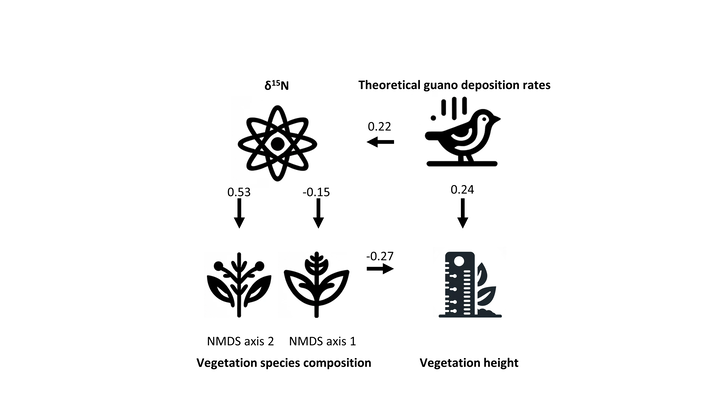F.F. van Rees1,2,3, L.L. Govers2,4 , P. Guseva1, M. Zwarts1,2, C. Tuijnman1, T. Rudde2, B.G. Ruessink1, K.C.J. Camphuysen2, V.C. Reijers1
1Utrecht University, The Netherlands; 2Royal Netherlands Institute for Sea Research, The Netherlands; 3Deltares, The Netherlands; 4University of Groningen, The Netherlands
* Corresponding author: floris.van.rees@nioz.nl
Introduction
Guano, or bird excrement, plays a crucial role in enhancing ecosystem productivity by boosting soil nutrients and promoting vegetation growth, a phenomenon well-documented on islands with hard substrates. However, the impact of guano on sandy islands remains underexplored, even though biogeomorphological processes are crucial for the development of these landscapes. In this study, we investigate the influence of shorebird guano on changes in plant community composition and plant traits occurring on sandy islands in the Dutch Wadden Sea. Our research objectives are multifaceted: firstly, to estimate theoretical guano deposition rates (TGDR) based on the spatial properties of bird colonies on these islands; secondly, to identify a reliable indicator for the transfer of nutrients from TGDR to vegetation; and thirdly, to determine if the nutrient flow from bird colonies alters the composition and traits of plant communities. This exploration sheds light on the significant ways avian colonies contribute to shaping sandy island ecosystems through bio-physical interactions.
Objective and Methods
To address our research objectives, our methodology unfolds in three key stages. Initially, we crafted a numerical model to calculate TGDR, transforming data on breeding bird colony characteristics—such as bird biomass, residence duration, and nest density—gathered by local nature reserve managers from five uninhabited sandy islands: Richel, Griend, Rottumeroog, Rottumerplaat, and Zuiderduin. Subsequently, we monitored the nitrogen transfer from bird guano to plants, determined through δ15N isotope analyses of plant samples collected from these islands. Finally, we evaluated the plant species composition and key vegetation traits (biomass, rooting depth, and height) at these locations. The assessment of plant species diversity was conducted using non-parametric multi-dimensional scaling, emphasizing the two primary axes. To unravel and quantify the complex interactions between TGDR, δ15N isotope levels, plant species composition, and vegetation traits, we employed a piece-wise structural equation model (PSEM) which included lagged spatial autoregressive models.
Results
Our analysis revealed that TGDR varied between different colonies. Larus ssp. had relatively low TGDR values, while Chroicocephalus ridibundus and Thalasseus sandvicensis had relatively high TGDR values, explained by low and high nest densities respectively. The TGDR was used as input for the PSEM. The PSEM global goodness-of-fit tests yielded significant results (Chi-Squared = 4.0, p = 0.6), indicating that the overall model fit was statistically significant, see Figure 1 for standardized coefficient estimates. Crucially, the model demonstrated a significant association between TGDR and δ15N levels (β = 0.22, p = 0.0239), highlighting effective nutrient transfer from guano to vegetation. This nutrient enrichment notably shifted plant community compositions towards species like Leymus arenarius and Elytrigia juncea, contrasting with areas less affected by guano, which favored Festuca spp. Additionally, the analysis showed that guano deposition positively influences vegetation height (β = 0.24, p < 0.05), suggesting an indirect role of birds in habitat formation through enhanced plant growth. These insights underscore the complex interactions between bird colonies and sandy island ecosystems, highlighting how guano deposition contributes to bio-physical interactions and landscape modification.

Outcome of the piece-wise structural equation model. The numbers represents the standardized coefficient estimate. It's the coefficient estimate scaled by the standard deviation of both the predictor and the response variables.


